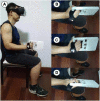Grip force makes wrist joint position sense worse
- PMID: 37323932
- PMCID: PMC10264640
- DOI: 10.3389/fnhum.2023.1193937
Grip force makes wrist joint position sense worse
Abstract
Background: The purpose of this study was to investigate how grip force affects wrist joint position sense.
Methods: Twenty-two healthy participants (11 men and 11 women) underwent an ipsilateral wrist joint reposition test at 2 distinct grip forces [0 and 15% of maximal voluntary isometric contraction (MVIC)] and 6 different wrist positions (pronation 24°, supination 24°, radial deviation 16°, ulnar deviation 16°, extension 32°, and flexion 32°).
Results: The findings demonstrated significantly elevated absolute error values at 15% MVIC (3.8 ± 0.3°) than at 0% MVIC grip force [3.1 ± 0.2°, t(20) = 2.303, P = 0.032].
Conclusion: These findings demonstrated that there was significantly worse proprioceptive accuracy at 15% MVIC than at 0% MVIC grip force. These results may contribute to a better comprehension of the mechanisms underlying wrist joint injuries, the development of preventative measures to lower the risk of injuries, and the best possible design of engineering or rehabilitation devices.
Keywords: grip force; joint position sense; joint reposition test; proprioception; wrist.
Copyright © 2023 Li and Li.
Conflict of interest statement
The authors declare that the research was conducted in the absence of any commercial or financial relationships that could be construed as a potential conflict of interest.
Figures








Similar articles
-
Intrarater reliability test of the ISOmetric power device-A new instrument for assessment of isometric force in six directions of wrist motion.J Hand Ther. 2021 Jan-Mar;34(1):100-108. doi: 10.1016/j.jht.2019.12.013. Epub 2020 Apr 13. J Hand Ther. 2021. PMID: 32299648
-
Influence of joint position on electromyographic and torque generation during maximal voluntary isometric contractions of the hamstrings and gluteus maximus muscles.J Orthop Sports Phys Ther. 2001 Dec;31(12):730-40. doi: 10.2519/jospt.2001.31.12.730. J Orthop Sports Phys Ther. 2001. PMID: 11767248
-
Motion of the distal radioulnar joint in extension and flexion of the wrist using axial CT imaging of healthy volunteers.J Orthop Sci. 2021 Jul;26(4):610-615. doi: 10.1016/j.jos.2020.07.003. Epub 2020 Sep 16. J Orthop Sci. 2021. PMID: 32948406
-
The relationship between wrist position, grasp size, and grip strength.J Hand Surg Am. 1992 Jan;17(1):169-77. doi: 10.1016/0363-5023(92)90136-d. J Hand Surg Am. 1992. PMID: 1538102 Clinical Trial.
-
Computer Modelling of Wrist Biomechanics: Translation into Specific Tasks and Injuries.Curr Rheumatol Rev. 2020;16(3):178-183. doi: 10.2174/1573397115666190119095311. Curr Rheumatol Rev. 2020. PMID: 30659546 Review.
References
LinkOut - more resources
Full Text Sources

